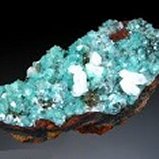
|
| Adamites |
Adamite is classified as a member of the phosphate class, and is included in the arsenate subclass. It has no commercial value as an ore, but is extracted in many places for sale to collectors as specimen pieces. The botryoidal crystals fluoresce strongly under ultra-violet light, showing a bright green color, and even in daylight theya re an attractive pale green and display a high adamantine luster. It is usually found on limonite, but is also associated with aragonite, calcite, mimetite, smithsonite, and many others. Adamite has similar crystal structures to olivenite and libethenite.
Adamite is capable of correcting imbalances of the heart over the intellect. If you feel you are excessively ruled by your emotions, adamite can be of great use to you. It also provides inner strength during stressful, emotional times and allows you to properly express how you are feeling.